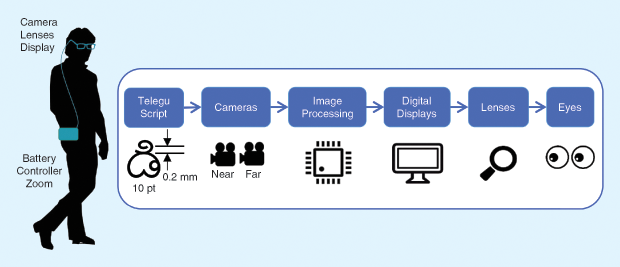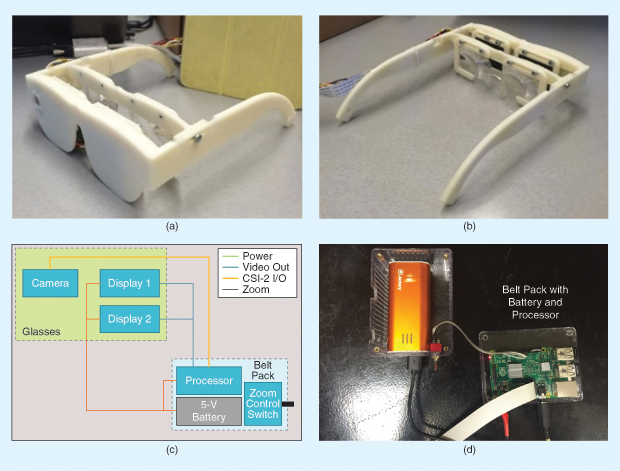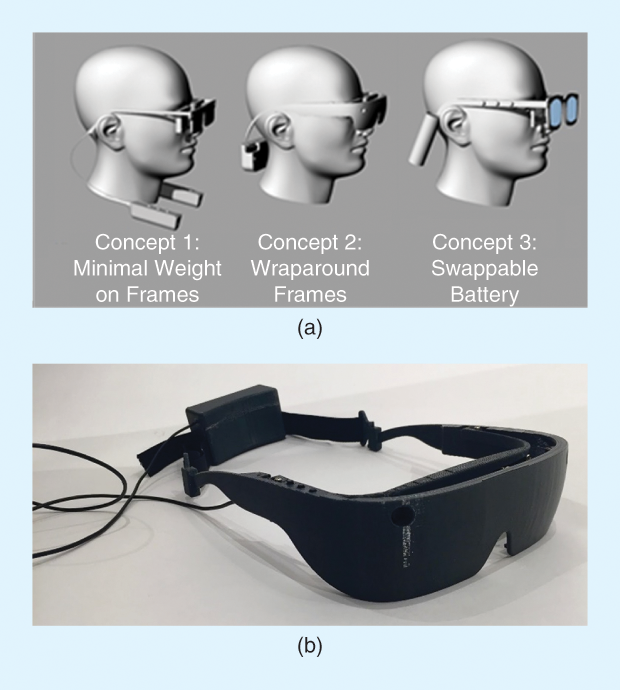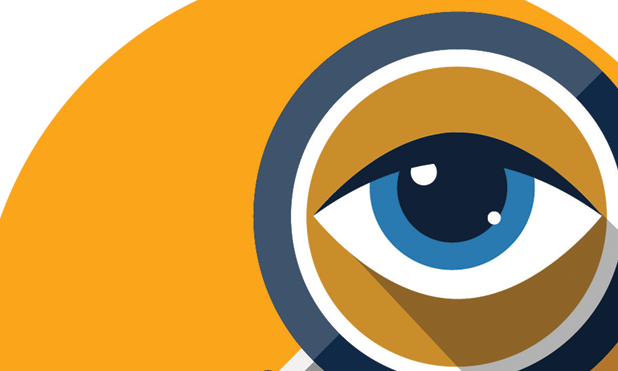A student squinting to see the board or holding a textbook inches from his or her nose often provides the first indication of a visual impairment. For most, the cause is a refractive error, readily correctible with eyeglasses. However, for an estimated 40–65 million people globally with functional low vision, the fuzzy words pose a lifelong challenge.
People with low vision, while not technically blind, suffer from a severe visual impairment that is not correctible optically or medically. As defined by the World Health Organization, even after the best possible correction, these individuals have a visual acuity between 3/60 (the threshold for blindness) and 6/18, with a visual field loss of 20 degrees or lower in the better eye [1]. Low vision has myriad causes and manifestations, including central and peripheral vision loss, scattered blind spots, contrast loss, and severe near- or farsightedness, as shown in Figure 1.

Available Assistive Tools
Residual vision can be enhanced by high levels of magnification; a host of assistive tools are available, including smartphone apps, handheld magnifiers, and larger tabletop systems. For distance viewing, the most reliable tool is glasses with a small telescope mounted to one of the lenses. Other wearable solutions typically fall into two categories: modified virtual reality glasses, which are bulky and not completely apt for the purpose, and smart glasses (including a model based on Google Glass) that read text, perform object recognition, and communicate audibly but do not actually enhance residual vision. Vision technology from eSight, a company in Toronto, Canada, is the only commercially available (albeit pricey) wearable magnifying device designed specifically for persons with low vision.
Low-vision students face particular challenges in the classroom, and it is here that assistive technology interventions are especially impactful. A student in the developed world, with access to financial resources through his or her school or family, may use a backpack full of gadgets, both digital and purely optical. These devices, combined with additional laptops, tablets, and stationary systems at home, can cost, in total, thousands of dollars. However, due to disease and poor eye care, low vision is disproportionally prevalent in the developing world [1], where these products are even more financially inaccessible. Students in both developing and developed counties are also faced with unique social challenges, and many refuse to use existing products because they are bulky and unattractive, calling immediate attention to their disability.
Recognizing the need for a better product, beginning in 2014, Massachusetts Institute of Technology (MIT) mechanical engineering researchers and students in the MIT 2.76 Global Engineering course teamed up with the L.V. Prasad Eye Institute (LVPEI) in Hyderabad, India, to develop a solution that is both affordable and tailored to the needs of low-vision learners.
Meeting Key Design Challenges
An investigation into the learning environment and existing products identified a gap in the solution space for a portable, attractive, hands-free wearable device with acceptable functionality. Users are willing to accept compromises on performance and features in a device that is aesthetically pleasing and comfortable. If a product is ugly or embarrassing, students will simply not use it consistently, regardless of its functional benefits. Users want a device that resembles typical accessories, such as sunglasses. Discussions with LVPEI and target users in India and the United States led to a design of the MIT-LVP magnifier that prioritizes aesthetics first, followed by function, and finally cost.
In the classroom, students have two specific use regimes: reading printed text in 10- to 12-point font at arms’ length (30–90 cm) and identifying writing on a blackboard at a distance of 3–6 m. To display printed text clearly, the device must enable the user to resolve 0.2-mm gaps in the printed font under 4–6-times magnification. To maintain spatial awareness, the field of view must display at least three words and two lines of text [2]. For blackboard writing, the device must provide approximately 3–6-times magnification focused at a distance. Because students need to quickly switch between writing and reading at their desks and copying from the blackboard, the ability to move rapidly and easily between the near and far focal points is critical.

While purely optical devices have cost advantages over digital devices, it was not possible to meet the magnification and focus requirements in a compact form factor using only optical components [3]. The digital–optical system architecture of the MIT-LVP magnifier is shown in Figure 2. The device uses a camera and digital zoom to present magnified real-time images to the user. This architecture allows for a relatively compact form factor with good functionality and is designed for a maximum price point of US$500. To achieve sufficient operating time while minimizing the volume and weight carried by the user’s nose and ears, the magnifier is designed with an external battery pack.
From Idea to Prototype
The design process has developed over three years, with student teams refining the specifications and the design iteratively each year. Overall, the design of the MIT-LVP magnifier emphasizes simplicity and robustness. Images are captured in real time, with the user manually selecting the desired zoom level. Using two prefocused, high-resolution cameras on the order of high-definition television (or higher) to capture images at both near- and far-field distances eliminates the need for complicated and expensive optical focusing and zoom mechanisms. The glasses provide enough information to produce interpretable images even after six-times digital zoom.
Target users reported that they found features such as auto-focus, image sharpening, and stabilization dizzying or unnecessary; however, the ability to invert black and white was beneficial. Eliminating unnecessary features reduced power consumption and processing requirements. Because high-fidelity images are not discernable by people with low vision, the MIT-LVP magnifier uses low-resolution displays that further reduce the cost of the device without compromising functionality. The battery pack is sized to provide four hours of continuous device use with screens at a high level of brightness, sufficient for one school day’s worth of reading.
Lenses mounted between the screens and the users’ eyes create a virtual image at a comfortable distance from the eye. For the magnifier to have an acceptable form factor, the distance between the lens and the eyes must be minimal. A traditional lens with acceptably short focal lengths would add at least 60 g to the device, so the MIT-LVP magnifier uses a thin, lightweight Fresnel lens. The distortion it introduces does not markedly compromise the image.

A functional prototype [2] of the magnifier, shown in Figure 3, was examined by assistive technology specialists, who also have low vision, at the Perkins School for the Blind in Watertown, Massachusetts, and at the LVPEI. This prototype used off-the-shelf Raspberry Pi-based electronics and components, and, while it did not represent the final target form, testers were able to use the device to read eye charts, papers, and signs. In general, they were impressed with the functionality and form factor. Additional potential uses were suggested, including reading bus timetables, shopping labels, and menus and viewing game pieces while playing board games. User feedback based on these cases gave credence to the hypothesis that an affordable, aesthetically pleasing, wearable device with basic functionality could add value to the assistive device market.
Three nonfunctional aesthetic prototypes were manufactured to explore radically different stylings of the magnifier and placements of the battery pack, as shown in Figure 4(a). Feedback on these designs from community members with low vision led to the final form factor, shown in Figure 4(b). All processing electronics are located in the frame, with buttons on the top of the temple for easy, one-handed control. The auxiliary battery pack hangs on a safety strap or can be detached to clip at a convenient location. The glasses have a wraparound sunglass structure to provide shading for the screens.

Path from Prototype to Product
The main technical requirements for the MIT-LVP magnifier have been identified, its form factor has been prototyped, and initial testing has confirmed that the device has strong potential in both developing and developed countries. Additional work is planned to further develop the magnifier into a marketable, mass-manufacturable product that can be sold commercially.
The next major step is to bring the aesthetic and technical together in an integrated prototype. This entails detailed component specification for manufacturing, laying out circuit boards, and squashing the cameras, circuity, lenses, and displays into the warped frames. Sizing and adjustment customizability will be needed to comfortably accommodate various face, nose, and ear types. Material and color choices will be important to maintain the aesthetic focus. Formal, approved testing procedures will be used to evaluate the target users’ ability to resolve at near and far field, fatigue (normal with any device), comfort, and the general perceptions of users and, if possible, their peers. This data, if positive, will serve to finalize the hardware and software design and set this project on the path toward being a commercially available product.
Simultaneously, a business case is in development that takes into account production cost, markups, sales channels, and pricing. While not explicitly a medical device, the electronics will require testing and regulatory approval. The team is taking an entrepreneurial approach to moving these digital glasses from the lab to the faces of students, and the team is open to licensing, partnerships, and spin-off possibilities.
Acknowledgments
We recognize all student team members, including the 2014 Global Engineering Low Vision Project team: Nicholas Ambrogi, Karl Gantner, Jaya Narain (now a team mentor), Rachel Dias Carlson, Anisha Gururaj, and Iris Zielske; the 2015 Project team: Boris Afinogenov, J.B. Coles, Sailashri Parthasarathy, Jessie Press-Williams, Ralina Tsykunova, and Anastasia Vasilenko; and the 2016 Project team: Olawale Akinwale, Andrew Brose, Emma Castanos, Dalia Leibowitz, Emma Nelson, and Ashely Whitey. We thank PremNandhini Satgunam and her colleagues at the L.V. Prasad Eye Institute for their continued and enthusiastic support. We are grateful to the Perkins School for the Blind’s assistive technology team, led by Joseph Martini, for their gracious feedback. The MIT Global Engineering class is supported by the MIT Tata Center for Technology and Design and the Tata Trusts.
References
- World Health Organization. (2007). Vision 2020: The Right to Sight Action plan 2006–2011. [Online].
- B. Afinogenov, J. Coles, S. Parthasarathy, J. Press-Williams, R. Tsykunova, A. Vasilenko, J. Narain, N. Hanumara, A. Winter, and P. Satgunam, “Wearable optical-digital assistive device for low vision students,” in Proc. IEEE 38th Annu. Int. Conf. Engineering in Medicine and Biology Society (EMBC), Orlando, FL, 2016.
- N. Ambrogi, R. Dias-Carlos, K. Gantner, A. Gururaj, J. Narain, I. Zielske, N. Hanumara, and A. Winter. Low vision system for rapid near- and far-field magnification switching. Presented at IEEE 37th Annu. Int. Conf. Engineering in Medicine and Biology Society (EMBC), Milan, Italy, 2015. [Online].



